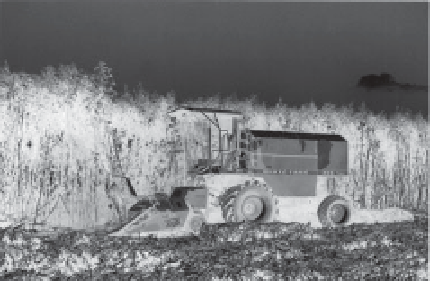Agriculture Reference
In-Depth Information
(a)
(a)
(b)
(b)
Fig. 6.15a and b.
Bulk handling and transport with
existing technology.
Fig. 6.14a and b.
Field harvesting with existing
technology.
Later, these bales are loaded on to a truck
by a tractor loader (1-2 at a time) (Fig. 6.15a
and b). The truck transports the bales to the
mill, where they are unloaded and again stored
under cover until they are then loaded one at a
time into the milling process.
To transport 15
t of bales to the point where they are being
processed takes 6 h for two workers and
associated equipment
.
Due to the fixed location of the tradi-
tional mill, crop production must be within
75 km of the processing location. The 'fixed
mill' issue will be dealt with later but, need-
less to say, this and other issues dealing
with distance to market or poor seasonal
growing conditions have further implica-
tions on overall efficiency, commercial risk
and extra costs.
so that it may feed evenly and easily into the
first stage of processing, or decortication.
Feed inconsistencies occur at this stage, due
mainly to the difficulty in untangling the com-
pressed stalk in the bales. This has a knock-
on effect at the first stage of processing,
usually a hammer mill, where the feed rate
alters significantly, resulting in stalks being
over or under milled before going to the next
phase. Currently, the world's largest mill has
a maximum input of only 6 t/h before the
material moves on to the primary processing
phase.
Problems with the existing technology/
approach above are:
1. Cost of harvesting, handling and process-
ing, which translates to market price, expen-
sive and not competitive.
2. Need for specialized harvester equipment
with no alternative crop usage.
3. Harvested crop time lying in field: risk, a
major factor where cutting, windrowing and
Stage 1 feed into processing system.
The
first requirement in milling these fibres is to
prepare the material by opening up the com-
pressed bale or cutting it into smaller sections




